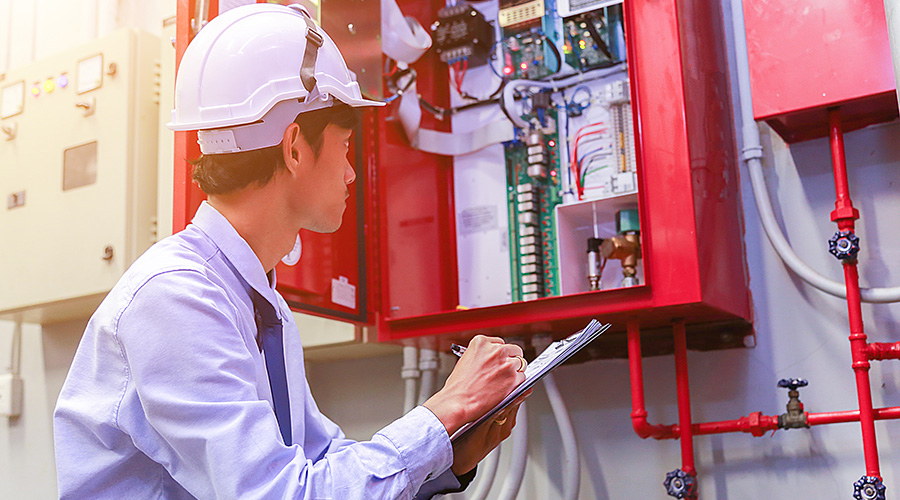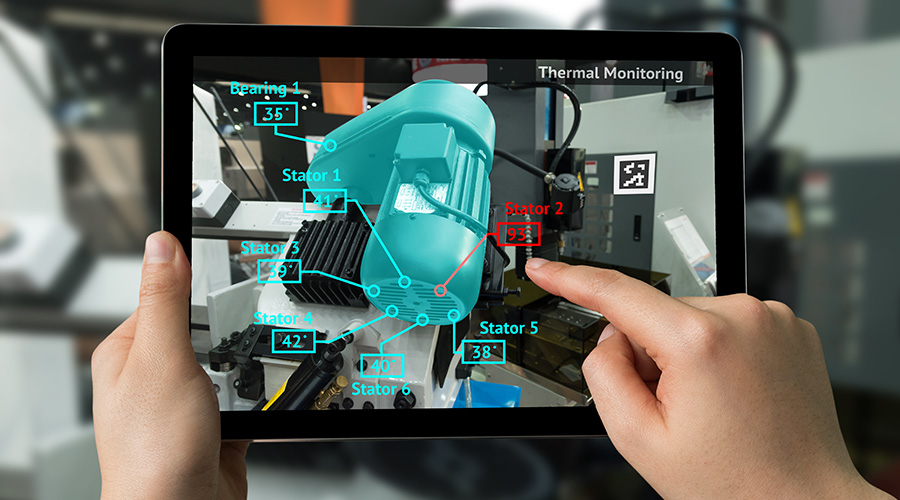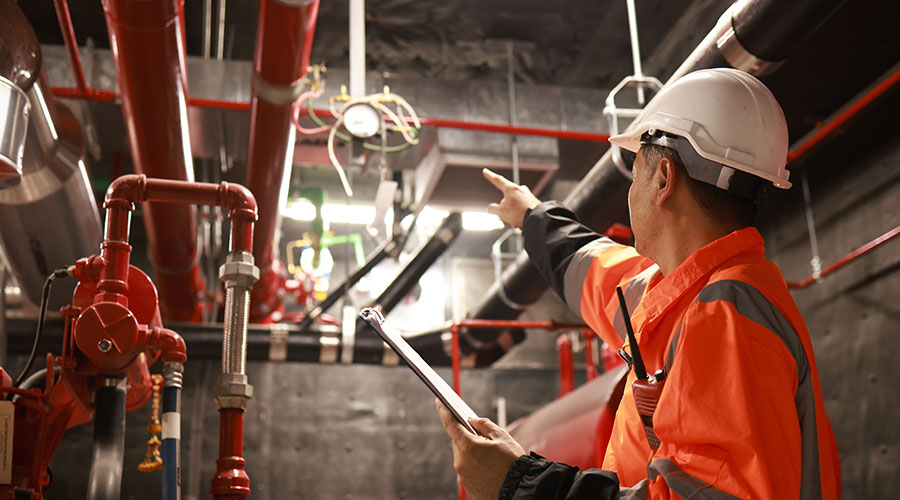Testing and inspection spell success for life-safety systems
The purpose of fire-protection and life-safety systems is to protect people and the buildings they occupy. Without fire-protection and life-safety systems that function properly, institutional and commercial facilities would be too dangerous to occupy and would not provide safe environments.
The key to providing such protection is the development of a program that delivers regular inspection, testing and maintenance of these systems.
The Newest Technology
In the last few years, fire-sprinkler-systems technology has virtually exploded in terms of the number and type of new sprinklers brought to market. The advent of quick- response sprinklers — those that respond early in a fire because they have very little thermal lag — has been responsible for a myriad of new special application sprinklers. Today, special sprinklers are available that:
- protect larger areas than ever before
- can be used with a window to provide a two-hour fire-resistive-rated barrier
- protect high-rack storage warehouses from the ceiling without the aid of additional in-rack sprinklers
- require less water pressure than their predecessors, which negates the need for a fire pump in some facilities, saving facilities sizeable capital and recurring costs.
New sprinkler technology requires lower pressures, but many facilities still use fire pumps to achieve proper water pressure, due to building height. Two concerns with fire pumps are the quick, high-pressure surge on the sprinkler system and the heavy load that pump motors place on electrical systems.
Many pump controllers now have soft-start capabilities. These controllers start a fire pump slowly and gradually increase its speed to the designed operating rate. This approach enables the sprinkler system to pressurize smoothly and decreases the risk of water hammer. Soft-start controllers are more expensive, but they can keep costs down because they often do not need new electrical service.
One of the newest types of fire-suppression systems uses a water mist to attack a fire. These systems use a spray of very fine water droplets to extinguish a fire and cool the surrounding area, and they typically require high pressures but a significantly smaller amount of water. These systems have been effective in extinguishing fires involving flammable liquids, live electrical equipment and even engine enclosures.
Programmable Protection
Today’s fire-alarm systems are extremely reliable and offer enhanced software capabilities. Systems of just a few years ago were plagued with false or nuisance alarms, creating dangerous “boy who cried wolf” situations.
Recent electronic and computer advancements have resulted in analog-addressable control panels. These new fire alarm panels can monitor each device — a smoke detector, for example — as a separate input. This set-up allows several different types of devices to be on the same circuit; smoke detectors and pull stations do not need their own circuits.
Users can program the control panel to display a short description of the device’s alarm, trouble or supervisory status. This capability is very useful for directing personnel to the exact location of a problem.
Addressable detection devices have some very useful features. Not only can they detect fires, but also they are discriminating enough to verify if a signal is truly a fire. Many detectors have a drift compensation feature that adjusts their sensitivity as they get dirty, so they stay as sensitive as if they were clean. Once they get too dirty, the control panel will sound a trouble alarm to indicate exactly which detector requires maintenance.
Detector sensitivity might be set from the control panel, and a walk-test feature allows building engineers to test these devices remotely without the need to introduce smoke into each detector.
As technology has advanced, many organizations have invested in specialized and sensitive electronic equipment to support and expand operations. The need to protect such equipment and facilities without the use of water also has become more common.
Previously, facilities used Halon 1301 systems in such areas. Due to the environmental impact of Halon on the ozone layer, manufacturers have developed new clean agents, or Halon replacements to protect areas containing highly sensitive, essential electronic equipment. These agents are not direct replacements for existing Halon systems; often, new agent distribution piping must be designed and installed to replace a Halon system.
System Maintenance Needs
Regular maintenance, inspection and testing of fire protection systems are essential to ensure the systems function and the facility is safe. Ultimately, a facility owner is legally responsible for maintaining the fire protection systems in good operating condition. Facility engineering staff, fire-system contractors and authorities with jurisdiction all are likely to be involved with system inspection and testing.
The engineering staff usually can conduct all of the weekly and monthly inspections, as well as most of the quarterly inspections. Activities that require testing or maintenance of the systems generally are best performed by a qualified fire system contractor. Outsourcing fire-system maintenance to a qualified contractor gives managers several benefits, including these:
- Contractors have specialized tools needed to maintain systems.
- Contractors have working relationships with manufacturers and suppliers of system components and spare parts.
- The contractor and facility owner share maintenance.
- The engineering staff benefits from a lighter workload.
When contracting fire system maintenance, a facility owner should make sure that the selected contractor regularly performs this type of work. Also, when negotiating such agreements, the owner and manager should review the details of the contractor’s scope of work to determine the activities the engineering staff will perform and the activities the contractor will perform.
Contractor Coordination
Too often when organizations outsource fire-system testing, managers neglect to coordinate the activities of different fire-system contractors. Since many fire-protection systems interconnect, it is crucial that contractors for each system — including sprinklers, fire pumps and fire alarms — are present when testing is performed.
This precaution allows facilities to conduct all testing at once, allows testing of system interconnections and allows for adjustment and retesting, if necessary.
Facility owners and managers are responsible for coordinating these different contractors, but this task can become time-consuming and frustrating. To remedy this problem, managers should establish a scope of work for inspection, testing and maintenance and deal with one contractor — such as sprinkler or fire alarm — and require the contractor to sub-contract with all other disciplines. This arrangement requires the prime contractor to be responsible for coordinating all other disciplines for simultaneous systems testing.
Facility maintenance and engineering staff must keep copies of inspection and testing records and secure copies of contractor-provided work. Such records should be kept at least one year after the next inspection or test is performed. Managers should keep maintenance records for the life of a system.
Obviously, maintenance and engineering managers are responsible for making sure these systems are ready to deliver on this goal — to protect facilities, occupants and visitors 24 hours a day, seven days a week.
Related Topics:











